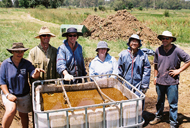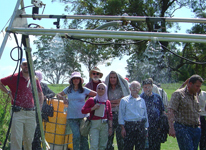
Background to the Centre for Recycled Organics in Agriculture

CROA is examining the effects of oily food waste on the soil
Government policies in New South Wales and elsewhere are placing increasing emphasis on beneficially reusing the resources contained in recycled organics and inorganic residuals. These products contain nutrients and organic matter which have the potential to improve plant growth, soil structure and water holding capacity, as well as suppress weeds and diseases.
Consequently, the agricultural and environmental rehabilitation sectors are seen as potential markets for recovered resources. However, few studies have quantified how recycled organics and inorganic residuals increase crop productivity, reduce variable costs, increase profitability or improve environmental outcomes.
Similarly, there is a lack of understanding of potential contaminants, such as heavy metals, chemicals and pathogens, in these products and how they behave in the environment. As such, uncertainty exists as to whether these products are “fertilisers” or “wastes” and whether they are appropriate for applying to agricultural land.

Rainfall simulators are used for erosion and runoff studies at CROA
In order to determine whether a recovered resource is a “waste” or a “fertiliser”, it is necessary to:
- develop options for the sustainable reuse of recovered resources;
- demonstrate these products are beneficial as fertilisers, either through providing organic matter and nutrients (macro or micro) or providing a soil conditioning effect; and
- ensuring any contaminants don’t pollute the environment.
This information can then be used to develop regulatory frameworks for encouraging the beneficial reuse of the resources contained within recovered residuals, whilst ensuring agricultural land is protected. This issue is one of the key drivers behind the establishment of CROA.
CROA home
